
Solana Network Booms: Is This Trend Sustainable?
Solana’s July was a rollercoaster of price fluctuations and record-breaking network activity. This analysis delves into the on-chain metrics and emerging trends shaping Solana’s future trajectory.
Key takeaways:
- Solana’s price experienced significant volatility in July, with a sharp rise to $193 followed by a slight correction. SOL price performance was influenced by potential ETF approval and overall market sentiment.
- Solana’s market capitalization increased by 21% in July due to the price surge.
- Solana’s network activity spiked in July, with non-vote transactions reaching a 7-day moving average of 46 million, the highest level since January 2022. The number of active and new addresses on Solana grew by 22% and 15% in July, respectively.
- Solana’s DEX volume surpassed Ethereum’s for the first time, reaching $55.87 billion in July. Raydium, a leading Solana DEX, was a key driver of this growth, with a staggering $30.12 billion in trading volume.
- Solana’s meme coin ecosystem experienced rapid growth, driven by platforms like Pump.fun and the upcoming U.S. election.
- Solana’s NFT market showed resilience, with sales rebounding 30% in July compared to June, despite overall market declines.
What is Solana?
Solana is an open-source blockchain platform founded in 2017 that emphasizes scalability and speed. With its unique Layer 1 network architecture, it processes over 710,000 transactions per second, enabling the creation of smart contracts and decentralized applications (dApps) for various use cases, such as decentralized finance (DeFi) and nonfungible tokens (NFTs) marketplaces. Unlike Ethereum, Solana does not require additional scaling solutions, relying on powerful computers for network maintenance and data storage. Its native cryptocurrency, SOL, is essential for transactions and network security through staking.
Solana in July: Price Up, Network Activity Booms
July 2024 was a rollercoaster month for Solana’s native token SOL. Starting at $147, the SOL price declined early in the month, reaching a low of $123 on July 5. However, the cryptocurrency staged a remarkable recovery and reached $193 on July 24, its highest level in four months, representing a 36% increase. By the end of the month, the price had pulled back slightly to $183.
This price spike could be attributed to investors’ high hopes for the possible approval of SOL’s exchange-traded fund (ETF) after Ether ETFs were approved for trading in the United States on July 22. The U.S. Securities and Exchange Commission (SEC) has set March 2025 as the final deadline for SOL ETF approval.
In July, the Solana network saw a significant surge in activity. The average daily non-vote transactions (transactions excluding validator voting) reached a 7-day moving average (7DMA) of 46 million on July 16, its highest level since January 2022. This represents a near 100% increase from its recent low of 21.9 million transactions in late April 2024.

Further analysis reveals 7DMA of 2.06 million active addresses on the Solana network daily, with each address executing over 30 transactions. This stands in stark contrast to Ethereum, where the average user conducts only two transactions per day. While this indicates high user engagement, it also underscores the challenge of converting this activity into sustained token price appreciation.
The number of active addresses in July reached 54.33 million, an increase of almost 22% compared to June. This metric has been growing steadily since April 2023, when this number was only 36.2 million, indicating 33% growth during the last three months.
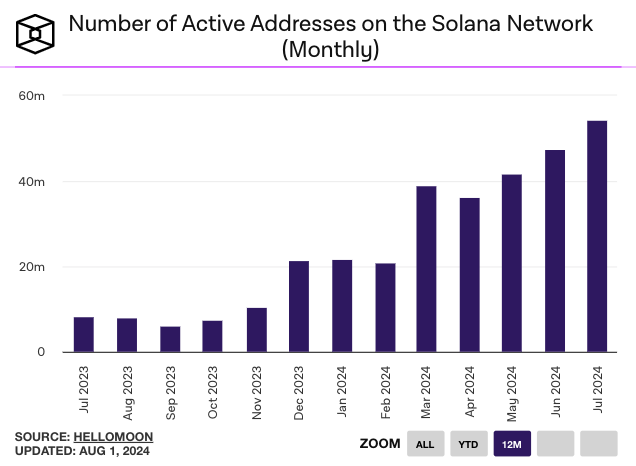
The number of new addresses joining the network is also showing signs of growth. Compared to June’s figure of 28.2 million new addresses, July saw a 15% increase, settling at 33.15 million.
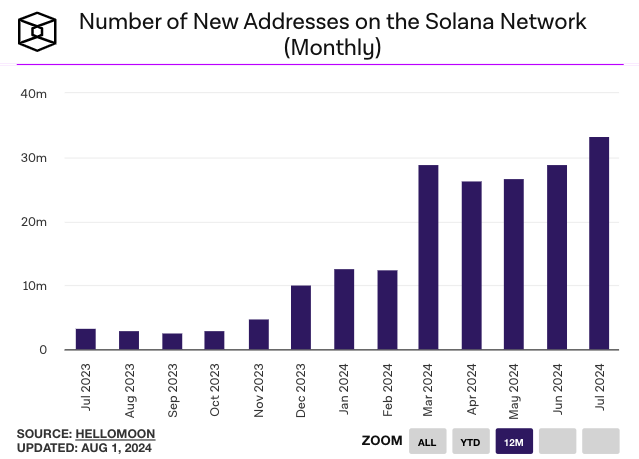
This increased activity can be attributed, in part, to the flourishing meme coin economy within the Solana ecosystem. Platforms like Pump.fun, which facilitate meme coin creation and trading, were a major contributor to this growth. These meme coins generate a high volume of non-vote transactions, including token transfers, smart contract interactions, and decentralized application (dApp) usage.
The surge in activity has also boosted Solana’s market capitalization. Currently valued at $78 billion, the token has experienced a 21% increase from its late April level of $61 billion.

The total value locked (TVL) within the Solana ecosystem stagnated near 30 million SOL for the past three weeks after peaking at 32.4 million SOL on July 8, the highest level since October 2022, according to DefiLlama data.
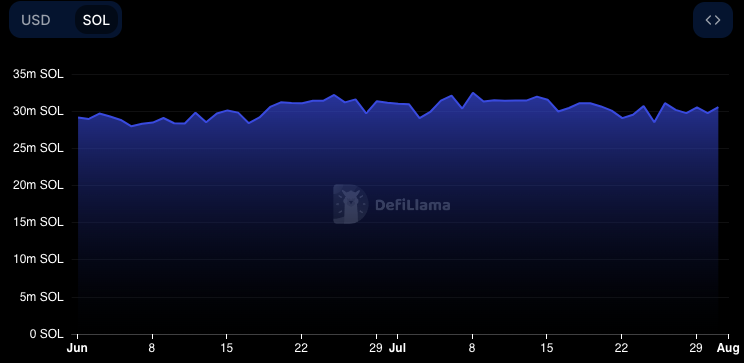
SEC Clouds Solana ETF Future
Possible spot Solana ETFs were a topic of much discussion in July, reflecting the continued uncertainty surrounding the regulatory landscape for cryptocurrencies in the United States.
SEC backs down on security classification for some tokens
The SEC’s shifting stance on classifying certain cryptocurrencies as securities will significantly impact the potential for Solana ETFs. On July 29, the SEC retracted its request to classify Solana, Cardano (ADA), and Polygon (MATIC) as securities in its lawsuit against Binance. This follows the SEC’s June 2023 claim that at least 68 tokens were securities, affecting over $100 billion worth of cryptocurrencies.
This designation subjects these crypto assets, including Solana, to stricter regulations, which can make trading and investing more difficult.
Institutional investors divided on Solana ETFs
Not surprisingly, investment giant BlackRock expressed limited interest in crypto ETFs beyond Bitcoin and Ethereum, which may dampen some investors’ enthusiasm for Solana ETFs.
Conversely, Franklin Templeton, a pioneer in the U.S. spot Bitcoin ETF market, is eyeing a Solana ETF, signaling a belief in the potential of this asset and its ecosystem.
On July 8, the Chicago Board Options Exchange (CBOE) filed two Form 19b-4 applications, one for the 21Shares Core Solana ETF and another for the VanEck Solana Trust.
The CBOE argued in its filings that Solana’s unique attributes, including its decentralized structure, high transaction speed, and robust throughput, make it inherently resistant to market manipulation. The exchange claimed this makes it comparable to Bitcoin and Ethereum, two cryptocurrencies that have already secured ETF approval.
According to Bloomberg ETF analyst Eric Balchunas, the SEC is expected to render a decision on these applications by mid-March 2025.
While Balchunas’ timeline and CBOE’s filings provide some clarity and hope, the lingering uncertainty about the SEC’s view of Solana as a potential security remains a significant hurdle.
Solana Ecosystem Heats Up in July
July 2024 was a busy month for the Solana ecosystem, with developments highlighting its potential to bridge the gap between cryptocurrency and traditional finance.
RWAs find a home on Solana
July started with a significant milestone: Agricultural platform AgriDex settled the first cross-border agricultural trade using real-world assets (RWAs) on the Solana blockchain. Over 200 bottles of olive oil and numerous wine cases journeyed from South African vineyards to London markets, with AgriDex streamlining the process and settling the deal. The platform charged a modest 0.15% fee on each side of the trade, demonstrating the potential for blockchain technology to revolutionize global commerce.
Solana-based PYUSD gains traction
Solana’s growing adoption was further evidenced by the rapid growth of the USDC (PYUSD) stablecoin, issued by payments giant PayPal. PYUSD’s market cap on Solana is approaching its Ethereum counterpart (supply of nearly $260 million since launch in May 2024 vs. $352 million since launch in August 2023, respectively).

This trend highlights the growing trust in Solana’s scalability and efficiency, making it an attractive platform for established financial institutions.
Stripe embraces Solana for crypto purchases
Payment giant Stripe has expanded its cryptocurrency services to Europe, allowing customers to purchase digital assets like Solana, Bitcoin, and Ethereum directly through their credit or debit cards. This move marks a significant step forward for crypto adoption in the region, providing easier access to digital currencies like SOL for a wider audience.
Solana’s Memes: A Frenzy Fueled by Hype and Opportunity
July 2024 was a wild ride for the Solana meme coin scene, fueled by a confluence of factors: innovative platforms, viral marketing tactics, and the ever-present hype surrounding potential Solana ETFs.
Solana-based meme coin launchpad Pump.fun, which facilitates rapid meme coin creation and trading, emerged as a key player. So far, over 1.5 million meme coins have been deployed via pump.fun, according to data from Dune Analytics.
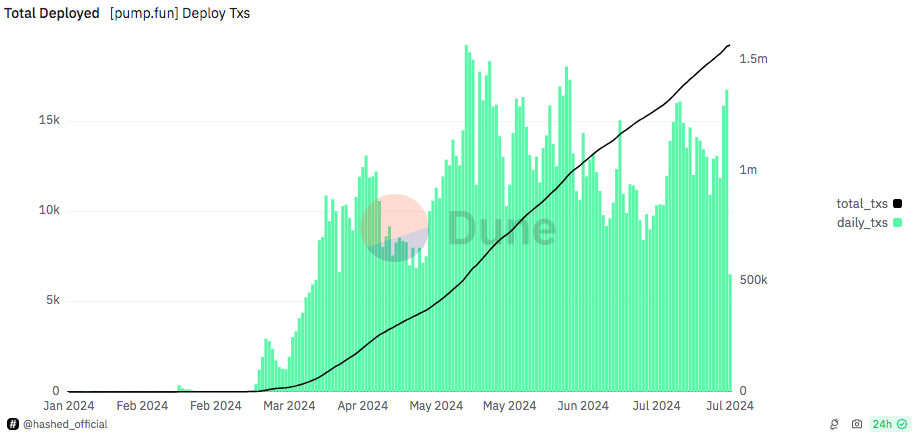
The upcoming U.S. election injected a layer of political intrigue into the meme coin frenzy. An unofficial Kamala Harris parody meme coin on Solana, KAMA, exploded by 422% over the past month. This surge coincided with growing pressure on U.S. President Joe Biden to drop out of the presidential race after a contentious debate with Donald Trump.

Biden-related meme coins fell over 60% on July 22 since the US president dropped out of the 2024 election. A notable meme coin trader reportedly incurred a significant loss of nearly $8 million after selling his Jupiter (JUP) tokens to invest at the peak of the BODEN meme coin.
The Make America Great Again-themed meme coin (MAGA), associated with Republican candidate Donald Trump, began the month at $6.21. It surged nearly 35%, reaching $9.51 on July 14. After this peak, MAGA’s value declined but stabilized at $6.18 on July 19 and then rose to $7.57 on July 21, following President Biden’s withdrawal from the race. However, this peak was temporary, as MAGA continued to decline, ending the month at $5.61 per coin.
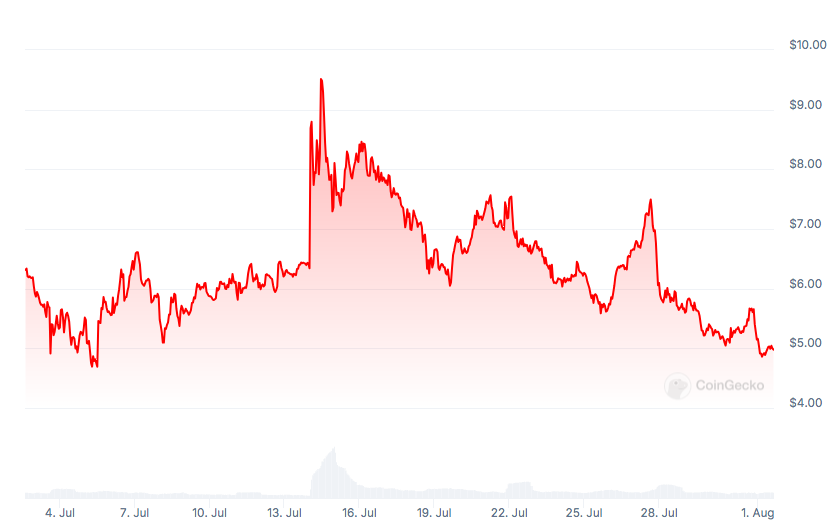
The largest Solana-based meme coin token by market capitalization – Dogwifhat (WIF) – dropped 9.3% in 30 days and nearly 19% in one week.
Meanwhile, July witnessed a surge in questionable marketing tactics. A prime example is the sudden appearance of a Solana-based meme coin, WATER, on Lionel Messi’s Instagram account. This unexpected endorsement led to a 55% price spike for WATER on July 8.
Solana DeFi is ascending to new heights
The Solana decentralized exchange (DEX) ecosystem maintained a high level of activity in July, surpassing Ethereum in trading volume for the first time. The SOL vs. ETH DEX volume ratio has hit an unprecedented 136%.
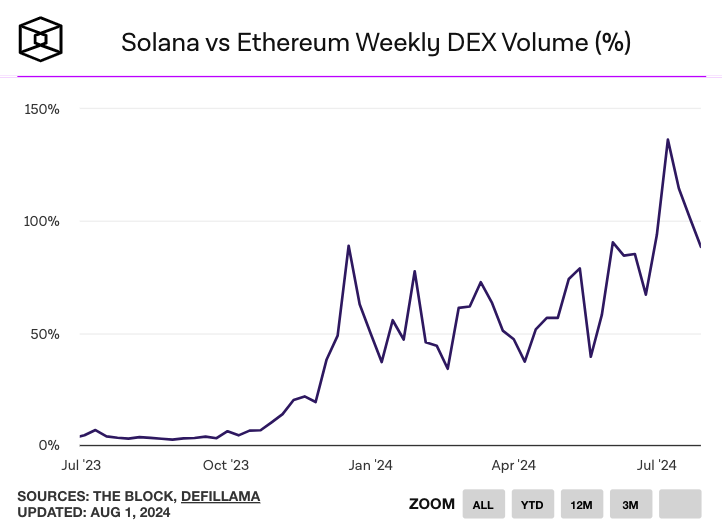
In July, Solana DEX trading volume reached $55.87 billion, an increase of 31% compared to June ($38.41 billion), reaching almost 30% of market share.

Raydium, a leading Solana DEX, was a key driver of this growth, with a staggering $30.12 billion in trading volume in July.
Leading liquid staking protocols Jito and Marinade have seen their TVL increase by 17% and 10%, respectively, over the past month. These platforms allow users to stake their SOL tokens while retaining liquidity, a feature that has proven increasingly popular within the DeFi landscape.
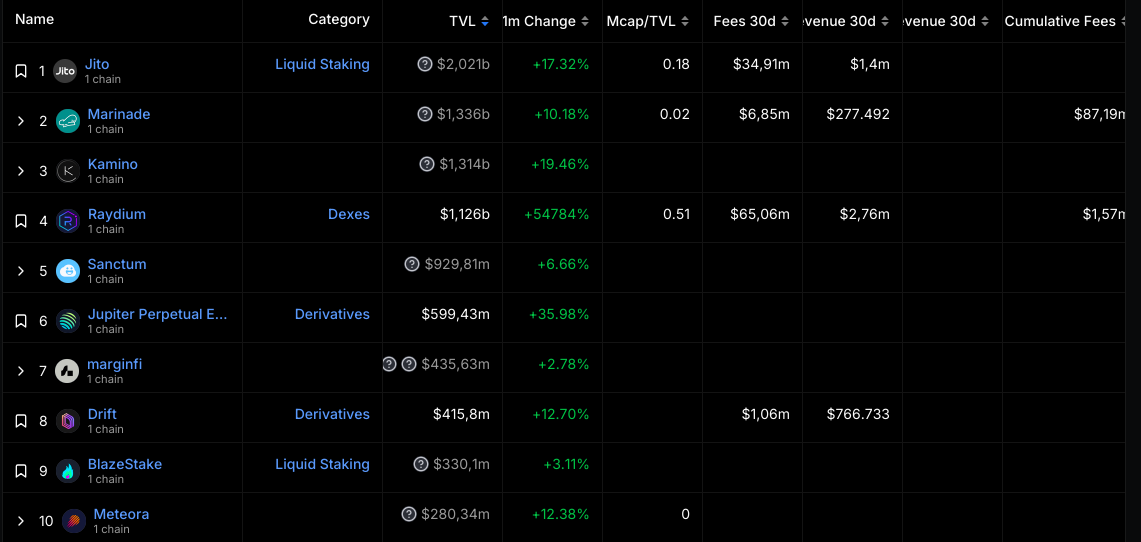
The proliferation of new tokens, especially meme coins, has fueled the DEX frenzy. Solana’s speed, low fees, and ease of use have made it an attractive platform for speculators seeking quick profits. While this rapid growth is impressive, it’s essential to monitor for sustainability and potential risks associated with speculative trading.
Solana’s DeFi Metrics Questioned
A recent research paper from Flip Research from July 30 casts doubt on the robustness of Solana’s dApp metrics. The report alleges that the platform’s high trading volumes are inflated by a preponderance of volatile, low-liquidity meme coins, creating fertile ground for malicious actors to exploit through maximum extractable value (MEV). The research suggests that the majority of Solana users are unknowingly losing funds to bad actors, raising concerns about the long-term sustainability of the network.
While the report’s assertion that Solana is fundamentally overvalued may be premature, the level of uncertainty surrounding the platform’s growth potential, as highlighted by the research, could prompt existing investors to reassess their positions.
Other updates around Solana DeFi:
- The month kicked off with Compute Labs, a Solana-based protocol for GPU tokenization, securing a $3 million pre-seed funding round. The round brought Compute Labs’ fully diluted token valuation to $30 million.
- The highly anticipated Firedancer validator client for the Solana blockchain will undergo rigorous testing as it launched its first bug bounty program. Developed by Jump Crypto, Firedancer aims to improve the performance and security of the Solana network. The six-week program, which launched on July 10, offers a $1 million reward pool for developers who can uncover critical vulnerabilities in the initial release of the client, called Frankendancer. By incentivizing security researchers, Jump Crypto aims to strengthen Firedancer before its wider adoption by the Solana community.
- Li.Fi, a popular platform for cross-chain swaps and bridging between Ethereum and Solana, was attacked on July 16, and over $11.6 million in cryptocurrencies was drained. A security update from Li.Fi revealed a flaw in code borrowed from the LibSwap library, which is used to facilitate calls between DEXs, service providers, and clients to coordinate the asset bridging and swapping processes. This oversight allowed attackers to bypass validation and steal millions from users who had a specific setting enabled. The Li.Fi team is working on enhancements to prevent similar attacks in the future.
Solana NFT Market Resilient Amidst Overall Slump
The NFT market shows no signs of recovery in July 2024. According to CryptoSlam, monthly turnover for July plummeted to $427 million. This follows a dismal June, where NFT sales totaled just $438 million, marking the lowest point since the previous October 2023.
In July, Solana regained the second place in the ranking of the most traded blockchain network in the NFT ecosystem, surpassed only by Ethereum.
Although Solana also noticed a decrease in NFT trading volume over the last 30 days, this decrease was relatively small (-7%) compared to other chains such as Ethereum (-36%), Bitcoin (-52%), or Polygon (-35%).
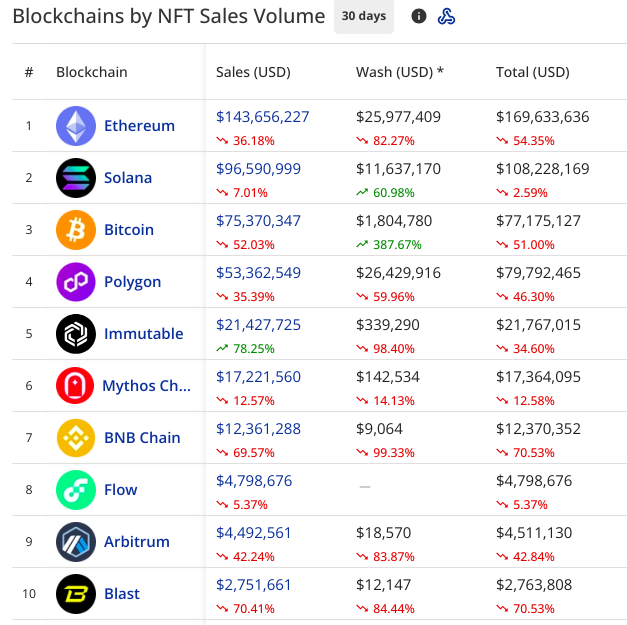
Compared to June, Solana’s NFT sales rebounded in July to $97.4 million, an increase of 30%. The data also showed that the Solana network attracted 452k buyers and 101k sellers, a decrease of 31% and 21%, respectively. The number of NFT transactions on Solana reached over 1.9k in July (+58%).

Solana’s recent growth can be partly attributed to the strong performance of its popular NFT collections like DogeZuki (+37% over the last 30 days), Solana Monkey Business (+266% over the last 30 days), and Froganas (+492%).
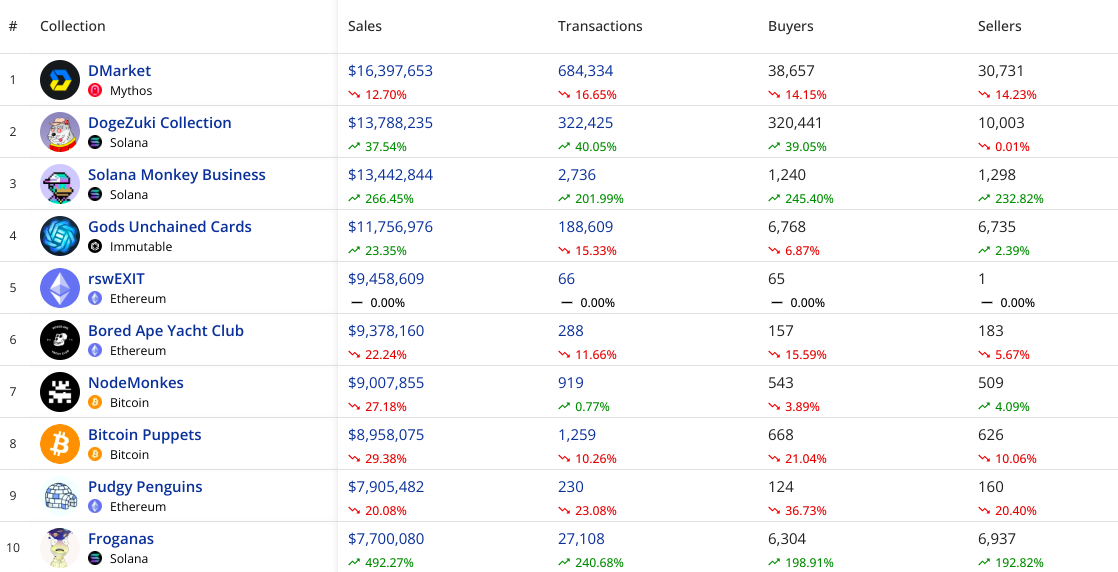
Notable NFT launches in July:
- Ark of Noah (July 1 – July 3): The Ark of Noah NFT collection is a pioneering initiative on Solana, aiming to preserve digital biodiversity through a unique collection of 10,000 generative animal NFTs. Each NFT is accompanied by an AON token, distributed exclusively to NFT minters. The project fosters community engagement through giveaways and rewards, with over 100 NFTs already distributed.
- Pitahayas On Sol (July 12 – July 19): Featuring 10,000 charming pixel art pitahayas, the collection blends art and agriculture in a unique NFT project. Inspired by a family’s organic dragon fruit farm, the project aims to bridge the gap between Web3 and real-world sustainability, with proceeds supporting farm improvements and rewarding NFT holders.
- Hamster NFTs (July 31 – August 7): Featuring a collection of 3,333 unique hamster characters, each NFT boasts its own distinct personality and appearance. These adorable creatures are ready to embark on digital adventures, making them a must-have for any NFT enthusiast.
Navigating Uncertainty and Fostering Sustainability
Solana’s July showed great potential but also faced many challenges. The uncertainty of regulatory approval for Solana’s potential ETF is a big obstacle. There are also worries about the long-term success of DeFi on Solana, especially concerns about market manipulation with meme coins and false transaction volumes.
Looking ahead, Solana needs to aim for stable growth in its DeFi ecosystem. This means promoting the creation of innovative dApps that go beyond meme coins, enhancing security, and attracting institutional investors who may be cautious of the unpredictable meme coin market.
While July highlighted the active nature of the Solana ecosystem, dealing with regulatory uncertainties and ensuring sustainable growth are essential for its future.



